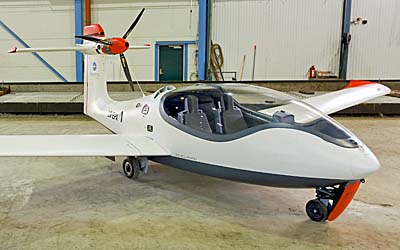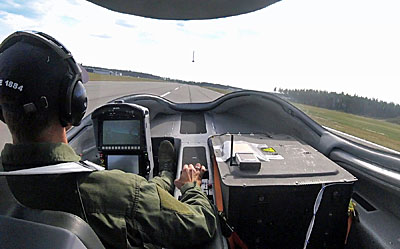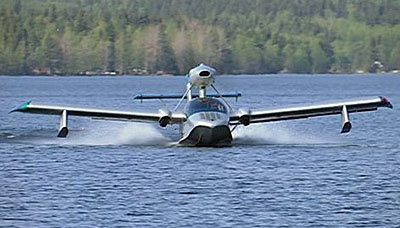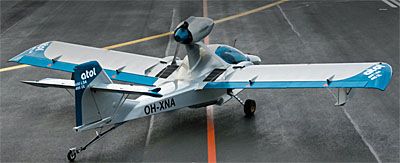In the fascinating LSA seaplane sector-within-a-sector, we find both good news and bad news today, though the latter can be overcome. That’s the shortest possible story. More detail follows.
The Good
“It is with great pleasure we can report that Equator Aircraft Norway achieved first fully balanced flight with the P2 Xcursion prototype aircraft over the newly painted runway 22 at Eggemoen Technology Park in Norway,” reported the company. Here’s our earlier report on this fascinating project.
 Tested by Eskil Amdal, Equator reportedly accelerated to 70 knots before leaving the ground and flying down the runway at 100 knots at nine meters (about 30 feet, at the edge of ground effect), before landing smoothly. Amdal reported stable flight with good controllability in all axes. Two more flights were performed the following day, further establishing confidence in the flying characteristics.
Tested by Eskil Amdal, Equator reportedly accelerated to 70 knots before leaving the ground and flying down the runway at 100 knots at nine meters (about 30 feet, at the edge of ground effect), before landing smoothly. Amdal reported stable flight with good controllability in all axes. Two more flights were performed the following day, further establishing confidence in the flying characteristics.
“The aircraft is a prototype developed by Equator with very limited means since 2010,” explained the company. “It can operate from land or water, and with its small electric motor, low float wings and good aerodynamics, promises to rival land planes on performance.”
“Equator’s core goal to make flying more available to more people, by supplying, green, silent and practical aircraft to the market,” added the company. Equator benefits from a very large space inside (nearby photo), and “a simple intuitive cockpit that makes it easy to learn to fly.”

Test pilot Eskil Amdal at Equator’s “minimalistic controls.” On the left is the test battery pack temporarily filling the passenger seat.
Equator hopes to deliver the aircraft both as a hybrid-electric and pure-electric aircraft. The current prototype is fully electric, is set up for testing only, and can fly for about 35 minutes. “Further development shows promise to deliver aircraft with at least 1 hour and 45 minutes of flight time,” explained Equator. “In hybrid configuration the aircraft has [the potential for a] range of 5 to 6 hours.”
Equator is actively looking for investors to move into production while also seeking a larger owner to make sure it can continue the process rapidly.
“It was a fantastic day for the team,” said Designer and CEO Tomas Brødreskift. “This marks the real beginning of the test program for the aircraft prototype. We are now looking forward to gaining actual flight data, and not to mention look forward to putting the aircraft on the water as soon as possible. We are thrilled to see the aircraft perform as expected, and can’t wait to test the aircraft further.”
The Bad
From a Finland online report, “A small company billed as Finland’s only plane maker saw a one-million-euro prototype of its amphibious plane go up in flames Tuesday morning after a training flight ended in a crash. Here is our last report on Atol’s move to production.

“The Atol chief executive recounted the events that led up to the crash. He said a pilot instructor and his trainee ran into problems on a training flight when the amphibian’s ‘hood’ opened up. The pilot decided to ditch the vessel.
“He explained that although there was a nearby body of water, the pilot determined that it was too shallow for a landing and opted to take the plane down for a controlled emergency landing in a forested area.”
Atol Avian said that it is not yet clear precisely why the plane caught fire, but speculated that a fuel tank behind the left wing ruptured. Both occupants were able to walk away from the crash although both sustained some burn injuries.
The Not-So Ugly

The aircraft retails for 169,000 euros ($199,000 at today’s exchange rate). Atol Avian currently has six planes in production. The amphibious side-by-side seating Atol 650 LSA is made out of wood composite with foldable wings. See all our earlier reports on Atol.
While the LSA seaplane sector of the Light-Sport Aircraft industry is developing some of the most interesting concepts, bringing these more complex products to market appears significantly more costly and time consuming than many non-amphibious aircraft that have preceded them. From Icon’s A5 that is still struggling to reach production numbers to the now-departed MVP and others, the sector is not exhibiting the same time-to-market timing as simpler aircraft.


Leave a Reply